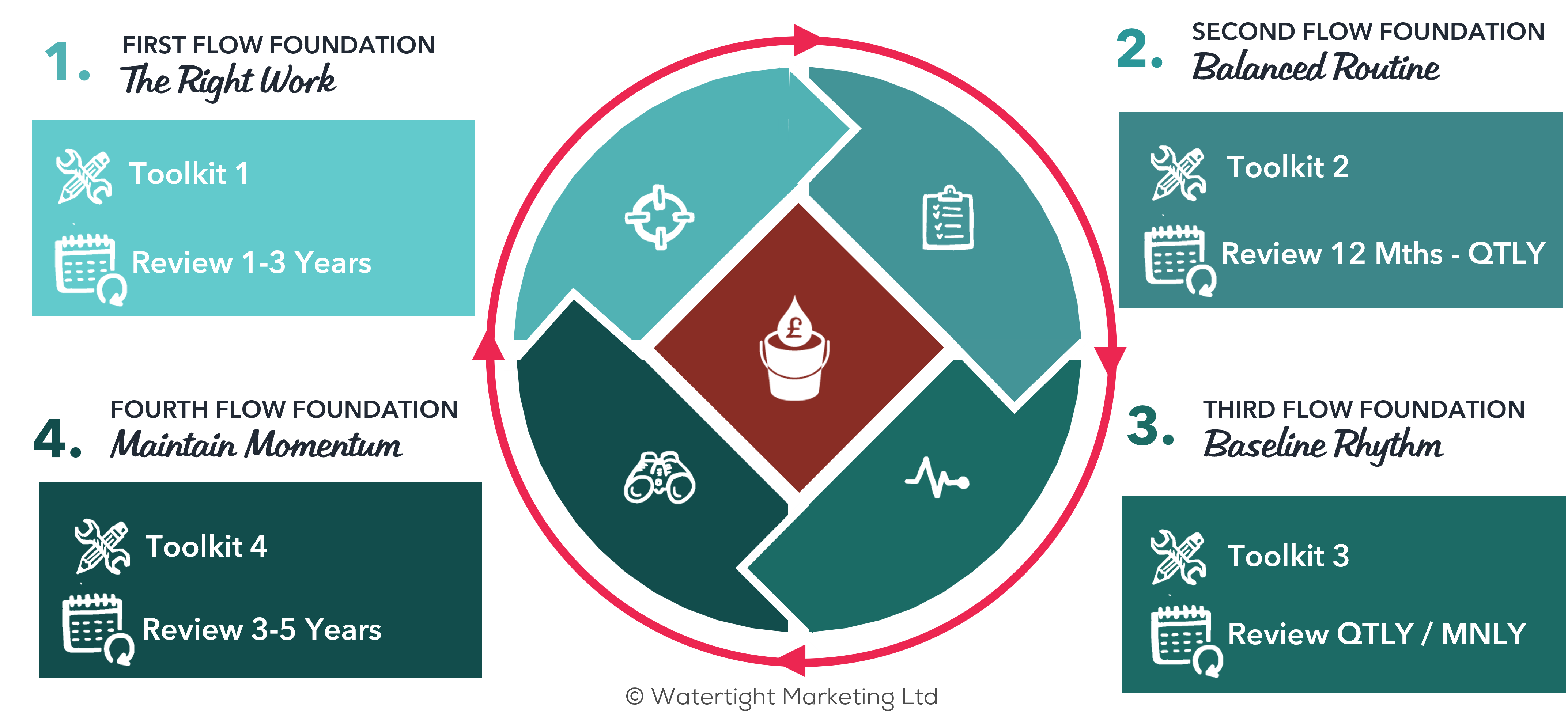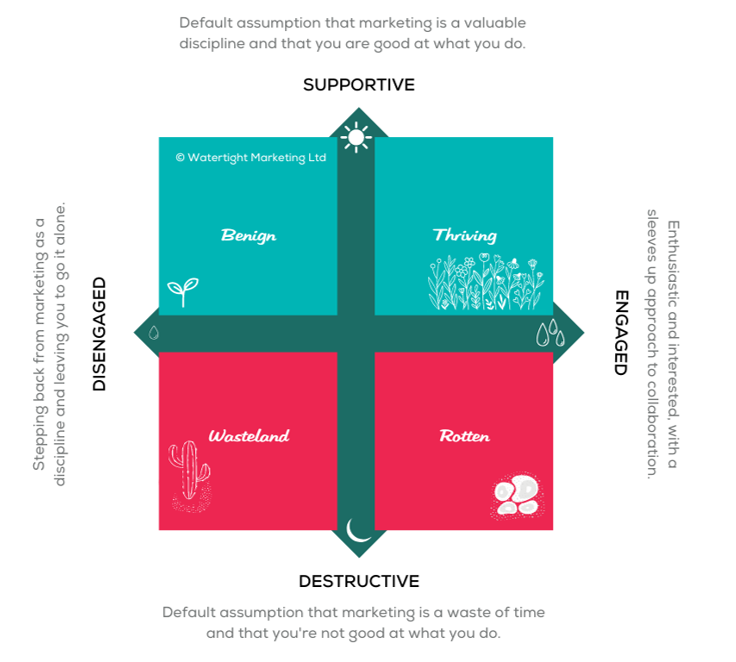Reading Time: 10 Minutes
“Why is it that the same marketer can thrive in one organisation and shrivel in another? It has a lot to do with what the leaders and other key players think about marketing: their perception of it, the level of support and encouragement – and what experience they have of what good marketing does.” ~ Rachael Wheatley, Managing Director | Watertight Business Thinking
Listen to the session podcast here
57 -minute roundtable discussion on what a business leader needs to know about marketing.
Over the years, working in-house and as consultants, we’ve seen three common situations which result in three different outcomes.
1. The disengaged leader – they’ve recruited a marketer, and know they need someone to take it on, but then they’ve taken a step back, leaving you (the marketer) to get on with it.
2. The sceptic – they’re not really sure what “marketing” does and have a suspicion it’s an expensive waste of time and money.
3. The champion – a leader who’s marketing-savvy, enthusiastic, interested, supportive.
No prizes for guessing which scenario enables the marketer and marketing team to thrive!
So what does a business leader need to know – and do – to make sure that scenario happens?
Rachael set-up the discussion by contextualising the topic within Watertight Marketing’s four Flow Foundations. These are an organising lens for how we see marketing within a business. The left hand side are the strategic foundations, and the right hand side the operational ones. Many business leaders view marketing as the operational and tactical activities, the more visible bits.

There’s usually a lot more thinking and planning that goes into the right hand side than many people appreciate; strategic projects such as mapping the customer journey, identifying who the influencers are, where you might have some gaps – these are all a prelude to a robust plan that will work.
On the left hand side, there is also strategic input with much of which the senior leadership team are involved. These Foundations answer questions such as: what are we selling and to which audiences? Where does our focus and priority need to be and why? What is our vision, values and plan? However, not all of the leadership team may realise these are also foundations for the marketing strategy and plan and that there’s a ‘bridging’ job from left hand side to right hand side to ensure the marketing is absolutely supporting the achievement of the business plan.
At the start of an engagement with clients, we invariably run a leadership team day where we introduce this concept. This builds a common understanding of what marketing is and isn’t, an appreciation of how aligned that team are on key areas, what their perception is of marketing’s performance and where there might be gaps.
At a minimum, we would suggest that business leaders need to know what’s involved in all of those Flow Foundations so that they can fully engage with the marketing team and contribute and collaborate when necessary.
How receptive is your organisation to marketing?
Receptiveness is characterised by the level of engagement and support that exists for marketing.
Rachael Wheatley: “We see this a bit like light and water on your marketing – seen like this, you can see the impact of having or not having, either or both.”

Thriving: This is what we all want. You’re trusted and respected, and your colleagues get involved – contributing ideas, preparing excellent content, spotting opportunities. This is where the very best marketing happens.
Benign: Highly supportive, but working with you at arms’ length, almost abdicating responsibility. In this environment, you’ll do ok – but you’ll never get the input from your non-marketing colleagues to really do your best.
Wasteland: This is where you’re tolerated rather than respected, and also left entirely to your own devices. There’s a disconnect in this that means even your best work goes to waste, with colleagues who won’t get on board.
Rotten: This is deeply frustrating. They have a low opinion of marketing and marketers, but also meddle and sabotage your every move. They turn up to meetings, not to collaborate, but to criticise. This is a horrible environment for any marketer.
Rachael Wheatley: “In my career, I think I’ve experienced all of them, though it was a Rotten individual rather than the business environment as a whole.”
What’s your experience of what leaders don’t know about marketing that you feel they need to?
Venetia Price: “I’m lucky in my organisation because my line manager, the CEO, supports marketing and understands what we’re trying to achieve and why. For people that maybe don’t have such a supportive line manager, it’s getting them to understand how marketing is key to delivering business growth – organic and new business – and how we can add value. So for organic growth, it’s understanding how we increase revenue from existing clients, how we can support this through effective key account management. It’s helping position the business as credible and understanding the prospect’s journey.
Rachael Wheatley: “Have you experienced a situation where your boss hasn’t been so supportive?”
Venetia Price: “I’ve been quite lucky in my career, because there’s been some great investment and support. In terms of not having such a supportive boss, then it’s really difficult. In that situation, I think they need to know we’re the key strategic focus for the business and we work alongside other functions to grow the business, identify new opportunities, new prospects, position products and services, support sales.”
Rachael Wheatley: “There’s often an educative aspect to our role, isn’t there? Sometimes it can take a leadership team some time to get to the stage where they understand that marketing is more than a few tactical activities. And it’s absolutely critical, for a marketer to thrive, to have a seat at the top table.”
Natasha Milsted: “I’ve worked in teams where I’ve been one person, and I sat on the SMT [senior management team]. And then I’ve worked in teams where it’s been much bigger and I haven’t had that exposure to the SMT. One of the things that as marketers we’re really good at doing is acting like swans and being really graceful, making everything look really easy and then panicking under the surface. That’s one of the things that people looking at marketing are missing. They see the tactical, the results; they don’t often see the work going into the strategic side of it, that they need more exposure to.
“It’s much harder to convince people that marketing is more than promotion, when you don’t have board level representation or a voice at every level of the organisation. As marketers, we’re collaborative people. We can offer solutions much wider then bringing growth, such as building the internal culture. We have a lot of skills that we could share – softer skills – that could really benefit a company. Such as running design thinking workshops or creating spaces where people feel safe enough to share their ideas.”
Rachael Wheatley: “One of the things that brings up for me is the point that marketing is not just about supporting customers. It can support other decisions, such as employee journeys. So when companies recruit new people, and want to on-board them, that’s a marketing job. So yes – we can absolutely use our skills in other areas.”
What if your boss changes and is less engaged with marketing?
Ben Wheeler: “When you asked: what does a business leader need to know about marketing, I substituted “know” with “care about”. I had a great relationship with an organisation for about a year and the leader got it. And then there was a change of person. Since working with this business, I had taken them from really quite tactical stuff to doing a lot of work around their employer brand, engagement of their people through enjoying their work and being motivated. But the new MD was less engaged with me, marketing, valued it less.
“I’m not sure what happened. I don’t know what his perception of marketing was. Certainly not receptive. I think it was partly my fault; when the transition came, I didn’t understand where I was with the new person. How can you assess how important that person thinks marketing is – because that affects your position? You should almost have a checklist of what that leader thinks, or needs to think. And then you can evaluate whether they meet your criteria or if you do work with them. They did recruit someone else after I left, but they lasted six months.”
Rachael Wheatley: “I wonder whether the reason they didn’t last was because the environment is now not one in which marketers could thrive. Unless you’re willing to take on the fight. It can feel like an uphill struggle, to change people’s comprehension of marketing, for it to become central to the business.”
How can you change the situation and ensure leaders and the wider business know what they need to about marketing?
Natasha Milsted: “Where I am currently, they’ve only centralised the marketing team in the last two years. Some of the challenges we have are exactly that. Previously they’ve had marketing people scattered around within events or policy, working just on promotion or specific events. They’ve never had a strategic element, no customer understanding. Because they value learning, I’ve taken advantage of that and been doing a lot of lunch and learns. It does feel like you have to go back to marketing basics.”
Rachael Wheatley: “So where are you on that journey?”
Natasha Milsted: “We’re still at the fundamental stages but there is a lot more buy-in now and lots more people round the organisation involved, inputting ideas. In terms of other ideas to help business leaders be more supportive and engaged and convincing them that we need to invest more in marketing, it’s giving them more sight of our metrics, data and return. They can see the results are better, but some cynics think it’s just because the markets are picking up!”
Rachael Wheatley: “I think if people understand the customer journey, or the volunteer journey or the supporter journey, and they understand the points in those decisions and what marketing you put in place to support it, then it becomes a little bit clearer how the marketing has helped get them to the end point.”
Natasha Milsted: “One of the other things business leaders need to know is that it’s not all about immediate return or short-term focus.”
Rachael Wheatley: “We often have those conversations about this mis-match between short-term horizons, looking for quicker sales, and marketing’s longer term time horizon.”
Ben Wheeler: “I have a persona – the 100 metre sprinter. They think it’s going to happen quickly, whereas it’s a marathon. It takes time to get to where you want to go, there’s things that you have to do to motivate yourself and recalibrate your race, but you get there.”
So, part of how we can change the situation is map out that journey and point to the time horizons piece.
Venetia Price: “In terms of the time horizon, people understand that it’s a case of building relationships over 18, 24, 36 months.”
Watertight Wisdom
What’s worked for us
Ideas from around the room about what a business leader needs to know and how you might change the situation if you needed to:
- That marketing is more than the visible bits – there is the thinking, planning, strategic foundations that make the visible bits work. Run a team day or a series of short training sessions that delve into what marketing is and does.
- Work first with people who are supportive – they can help you gain some credibility and support your cause.
- Develop internal relationships – go to them, talk to them, ask them about their objectives, listen, show you care. This helps to build trust and helps to break down barriers.
- Eat your elephant piece by piece – you can’t address all of the challenges, so decide which you want to deal with first. Then revisit in a few months and agree the next one you want to tackle.
- Treat your colleagues like customers – understand their experience of marketing (including before this company) and how they can and want to get the value from marketing. They’ll respond more warmly.
- Ask the right questions – by asking questions on strategic marketing topics (tell me more about your customers, what are their key challenges, how do they buy) you’re both showing that marketing is more than the visible bits and building credibility and trust.
- Consider education – regular things like lunch and learns, marketing training courses bringing in people from around the business.
- Collaborative projects – running strategic marketing projects across the business helps to build relationships and examples the depth and reach of marketing.
What would you add to our list? Do let us know your thoughts.
To join the conversation at our next Watertight Wednesday marketing roundtable you can sign up here. We’ll be having a chin-wag about how to get your FD loving marketing.
Sign up to Webschool to access our free course:
The MD’s Essential Marketing Checklist

Rachael Wheatley
Managing Director, Watertight Thinking
Rachael brings over 30 years’ of marketing experience, with a particular focus on building and developing effective marketing teams that are able to act as a strategic driving force across an organisation. She has worked with Watertight since 2014 as a Master Practitioner and joined the business as MD in 2022.



